Have you ever craved a meal that feels like pure comfort but is elegant enough to impress at a dinner table? Tender short ribs are the answer you’ve been looking for. Slow-cooked to perfection, they’re the kind of dish that falls apart with the touch of a fork, delivering rich, savory flavors in every bite. Whether you’re preparing a special family dinner or hosting guests, short ribs strike the perfect balance between indulgence and simplicity.
List Of Contents
Understanding Short Ribs
Short ribs come from the lower rib section of beef cattle. Unlike traditional rib cuts, they contain a mix of muscle, bone, and fat that delivers an intense, beefy flavor when cooked. The defining feature of short ribs is their connective tissue, which requires careful preparation to ensure tenderness. Check out more recipes here.
Anatomy of a Short Rib Cut
Short ribs are comprised of:
- Bone: Adds structure and contributes to the overall flavor.
- Meat: Heavily marbled, ensuring a moist and flavorful bite.
- Connective Tissue: A tough component that breaks down over extended cooking.
Types of Short Ribs
- English Cut: Large chunks of meat cut parallel to the bone, ideal for slow braising.
- Flanken Cut: Thin strips cut across the bones, common in Korean barbecue.
Each cut has its culinary advantages, but the method of cooking determines whether they achieve maximum tenderness. Check out more recipes here.
How Short Ribs Differ from Other Cuts
Unlike brisket or chuck roast, short ribs require both heat and time to fully develop their texture. Their unique combination of fat and connective tissue sets them apart as a highly versatile and rewarding cut. Check out more recipes here.
The Science of Tenderness
Why Connective Tissues Are Tough
Short ribs are rich in collagen, a protein responsible for the toughness in uncooked meat. To soften, collagen must break down into gelatin, which occurs only at specific temperatures and over long periods. Check out more recipes here.
Collagen Breakdown and Gelatin Formation
Cooking short ribs slowly at low temperatures causes:
- Collagen to dissolve into gelatin.
- Gelatin to coat the meat fibers, resulting in a luscious, tender texture.
Impact of Fat Content on Tenderness
The high-fat content of short ribs:
- Keeps the meat moist during long cooking.
- Enhances flavor when properly rendered.
However, insufficient rendering can lead to greasy or chewy meat. Check out more recipes here.
Moisture Retention During Cooking
Maintaining moisture is critical. This is why methods like braising or slow cooking, which use liquid, are preferred for achieving tenderness.
How Heat Affects Proteins
The interplay of heat and protein is delicate:
- Temperatures too high can dry out the meat.
- Controlled, low heat enables even breakdown of muscle fibers and connective tissue.
Cooking Methods for Short Ribs
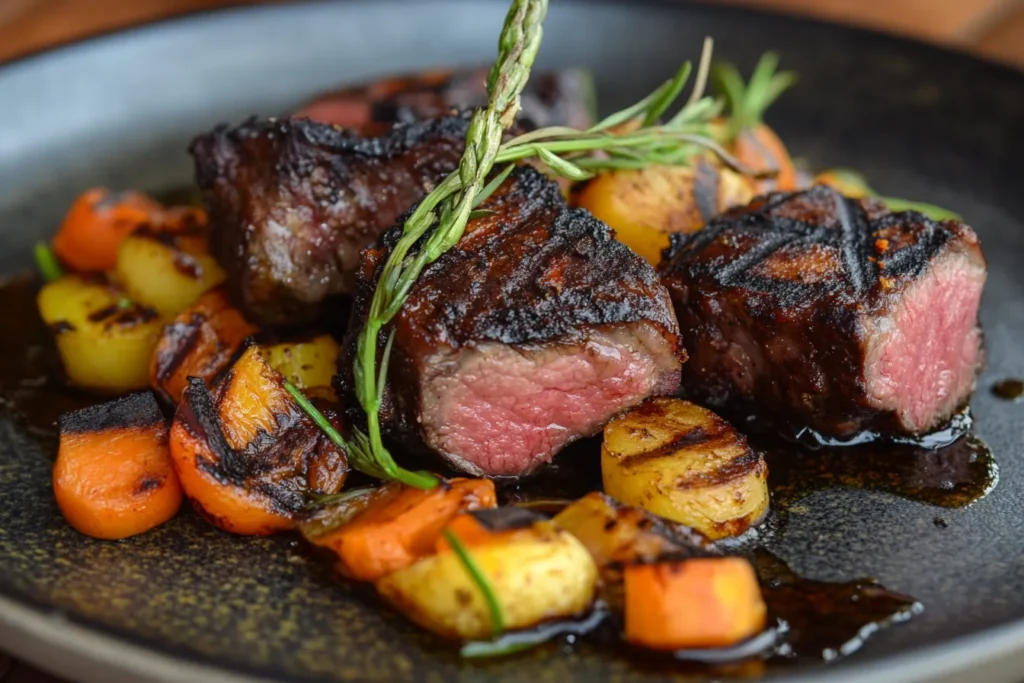
Braising: A Popular Choice
Braising combines wet and dry cooking techniques. The meat is seared before being simmered in liquid, creating:
- Deep, caramelized flavors.
- A moist environment that facilitates collagen breakdown.
Smoking and Barbecuing
For those who enjoy smoky flavors, barbecuing short ribs at low temperatures over several hours achieves both tenderness and a crusty bark.
Slow Cooking in a Crockpot
A crockpot simplifies the process:
- Even, prolonged heat distribution.
- Minimal effort while locking in flavors.
Sous Vide Techniques
Sous vide offers precision:
- Meat is vacuum-sealed and cooked in water at a controlled temperature.
- The method guarantees perfect doneness without the risk of overcooking.
Comparing Dry and Wet Heat Cooking
- Dry Heat (e.g., grilling, roasting): Produces a robust crust but may lead to uneven tenderness.
- Wet Heat (e.g., braising, slow cooking): Yields consistent tenderness and rich flavors.
Do Short Ribs Get More Tender Over Time?
Factors Influencing Tenderness
Key factors include:
- Cooking time and temperature.
- The cut and amount of connective tissue.
- Whether moisture is adequately maintained.
Low and Slow Cooking: Pros and Cons
- Pros: Maximizes tenderness by breaking down collagen.
- Cons: Extended cooking risks drying out or over-tenderizing.
The Plateau Phase Explained
During slow cooking, short ribs often hit a plateau phase:
- The temperature stabilizes while collagen melts into gelatin.
- Patience during this phase ensures a tender result.
When Overcooking Can Happen
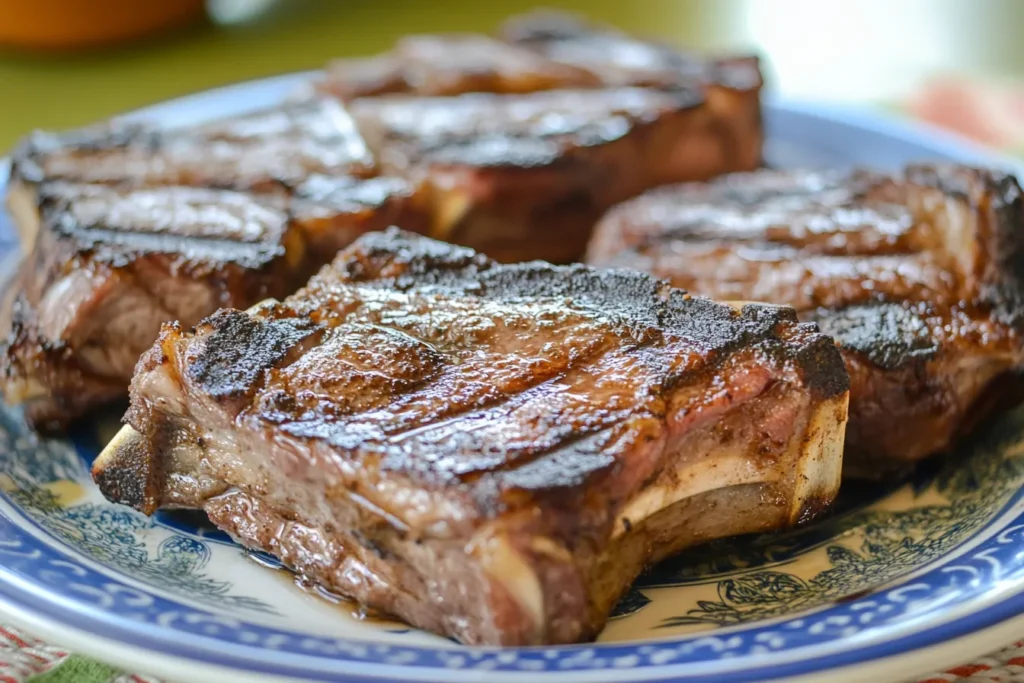
Even slow-cooked meat can suffer if:
- Left for too long, turning gelatin into mush.
- Exposed to excessive heat, resulting in dryness.
Signs That Short Ribs Are Perfectly Cooked
Perfect short ribs:
- Are fork-tender but retain structure.
- Have a rich, glossy coating from rendered fat and gelatin.
The Role of Cooking Time in Tenderness
How Long Is “Long Enough”?
Generally, short ribs take:
- 3-4 hours when braised at 275°F (135°C).
- 6-8 hours in a slow cooker on low heat.
Cooking Times for Different Methods
- Sous vide: 24-48 hours at 130°F-165°F.
- Smoking: 6-8 hours at 225°F.
- Oven braising: 3-4 hours at 325°F.
Temperature Guidelines for Short Ribs
- Collagen melts: 160°F (71°C) and above.
- Safe serving temperature: 190°F (88°C) for optimal tenderness.
Trial and Error Approach
Mastering short ribs often requires:
- Experimenting with different cuts and cooking methods.
- Adjusting times and temperatures to suit personal taste.
Undercooking vs. Overcooking
One of the most common pitfalls in preparing short ribs is misjudging the cooking time:
- Undercooking results in tough, chewy meat because collagen hasn’t had enough time to break down.
- Overcooking can make the meat overly soft, to the point of losing its structure and becoming mushy.
How to Avoid This Mistake:
- Monitor internal temperatures with a meat thermometer.
- Stick to the recommended cooking times for your method.
Not all short ribs are equal.
For example:
- English cut is best for braising.
- Flanken cut excels in grilling or quick cooking.
Solution: Choose the cut that matches your cooking method. For low-and-slow techniques, always opt for English-cut short ribs.
Failing to Season Properly
Short ribs require generous seasoning due to their thickness and marbling:
- Under-seasoning leads to bland meat.
- Skipping marinades or dry rubs limits the depth of flavor.
Pro tip: Always season your ribs a few hours (or even a day) before cooking. This allows the flavors to penetrate the meat.
Skipping the Searing Process
Searing before slow cooking enhances flavor by caramelizing the surface of the meat. Missing this step often results in a lack of complexity in the final dish.
How to Correct This:
- Heat a cast-iron skillet or Dutch oven to high heat.
- Sear each side for 1-2 minutes until a deep brown crust forms.
Neglecting to Monitor Liquid Levels
For methods like braising, the liquid level is crucial:
- Too little liquid risks drying out the ribs.
- Too much liquid dilutes the flavors.
Fix: Keep the liquid level at about halfway up the meat during cooking, adding more as needed.
Tips for Perfectly Tender Short Ribs
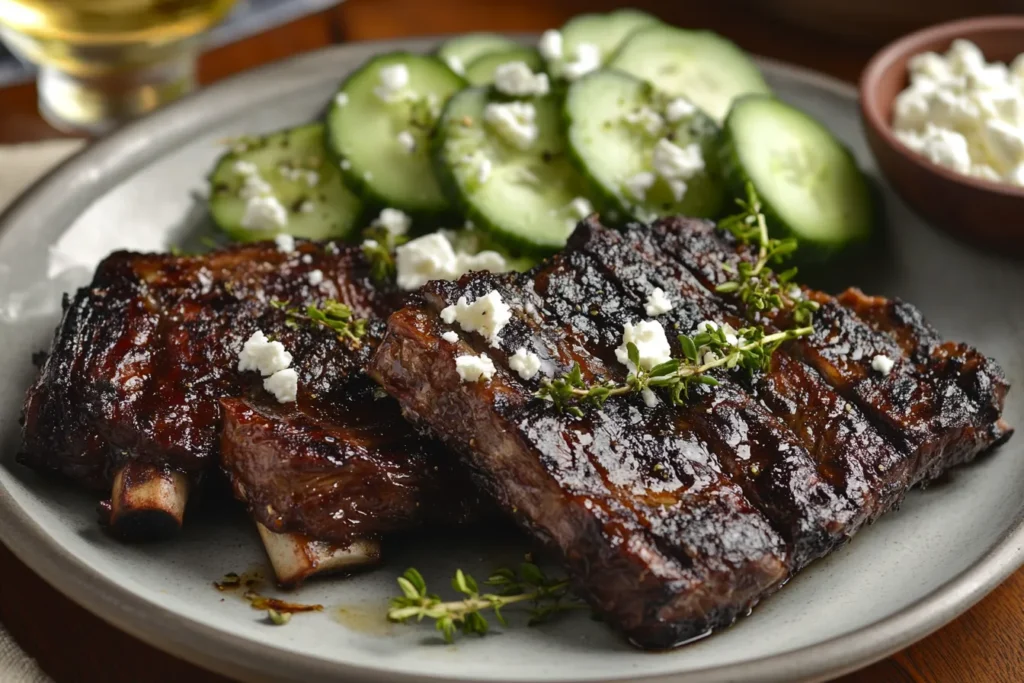
Prepping the Meat Correctly
Proper preparation sets the stage for success:
- Trim excess fat to prevent greasiness.
- Allow ribs to reach room temperature before cooking for even heat distribution.
Optimal Cooking Temperatures
Cooking temperatures are critical:
- For braising: Maintain 275°F-300°F (135°C-150°C).
- For slow cooking: Set the crockpot to low for the best results.
- For sous vide: Cook at 130°F-165°F (54°C-74°C) depending on desired doneness.
Choosing the Right Cooking Equipment
Invest in tools that ensure consistent results:
- A heavy-duty Dutch oven for braising.
- A meat thermometer to monitor doneness.
- A slow cooker or sous vide machine for convenience and precision.
Enhancing Flavor with Marinades
Marinades add complexity to short ribs:
- Use acidic ingredients like red wine, vinegar, or citrus to help tenderize the meat.
- Add aromatics such as garlic, rosemary, or thyme for depth.
Balancing Tenderness and Texture
Achieving tenderness doesn’t mean sacrificing texture:
- Cook just until the meat is fork-tender but still holds its shape.
- Avoid prolonged cooking at excessively high temperatures.
Pairing Flavors with Short Ribs
Best Spices and Herbs
Short ribs benefit from bold seasonings:
- Spices: Paprika, cumin, black pepper, and cloves.
- Herbs: Rosemary, thyme, bay leaves, and parsley.
Complementary Side Dishes
Pair short ribs with:
- Mashed potatoes: Their creaminess balances the richness of the meat.
- Roasted vegetables: Add texture and variety to the meal.
- Polenta: A hearty option that soaks up sauces beautifully.
Classic Red Wine Pairings
Rich, tannic wines enhance the flavors of short ribs:
- Cabernet Sauvignon
- Syrah/Shiraz
- Zinfandel
Sauces and Gravies That Work Well
Short ribs shine with:
- Red wine reduction: Adds depth and tanginess.
- Mushroom sauce: Earthy and complementary.
- Barbecue glaze: Perfect for grilled or smoked ribs.
Creative Serving Ideas
Think outside the box:
- Serve shredded short ribs over pasta or risotto.
- Use them as taco or sandwich fillings.
- Create fusion dishes, such as short rib ramen.
Troubleshooting Short Rib Cooking Issues
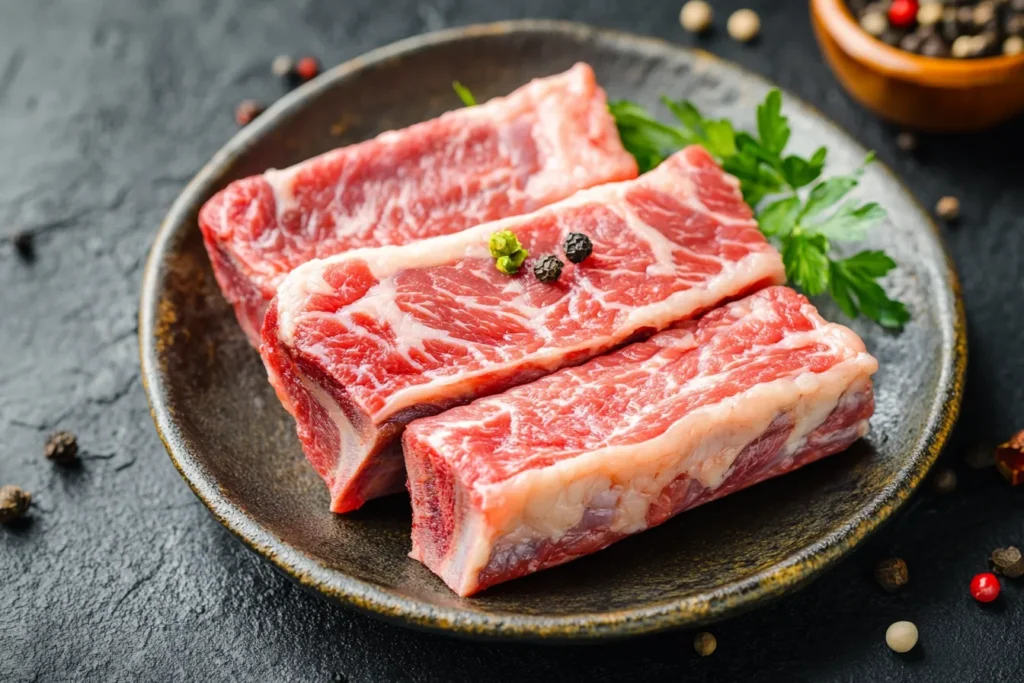
Tough After Cooking: What Went Wrong?
If your short ribs are still tough:
- The cooking time might have been too short.
- The temperature may not have been low enough to melt the collagen.
Fix:
- Extend the cooking time and keep the heat consistent.
- Ensure the internal temperature reaches at least 190°F (88°C).
Too Tender and Falling Apart: Is It Overdone?
Overcooked short ribs lose their texture and can become mushy.
Solution:
Cook until just fork-tender, and use a thermometer to avoid exceeding 200°F (93°C).
Balancing Juiciness and Tenderness
The key is moisture retention:
- Use a covered vessel for braising to trap steam.
- Avoid opening the oven or slow cooker too often.
Fixing Flavorless Short Ribs
Lack of flavor stems from:
- Insufficient seasoning.
- Using water instead of broth or wine for braising liquid.
Pro Tip:
Always use flavorful liquids and season generously.
Salvaging Mistakes
If the meat is too tough:
- Slice it thinly and serve with plenty of sauce.
- Repurpose it into soups or stews where additional cooking can help tenderize it.
Short Ribs in Culinary Traditions
Korean Galbi: Short Ribs in Korean BBQ
Flanken-cut short ribs are marinated in a soy-based mixture and grilled over an open flame. The result? Sweet, smoky, and tender ribs.
French Braised Short Ribs
Braised in red wine with aromatics, French-style short ribs are a classic comfort food often served with mashed potatoes.
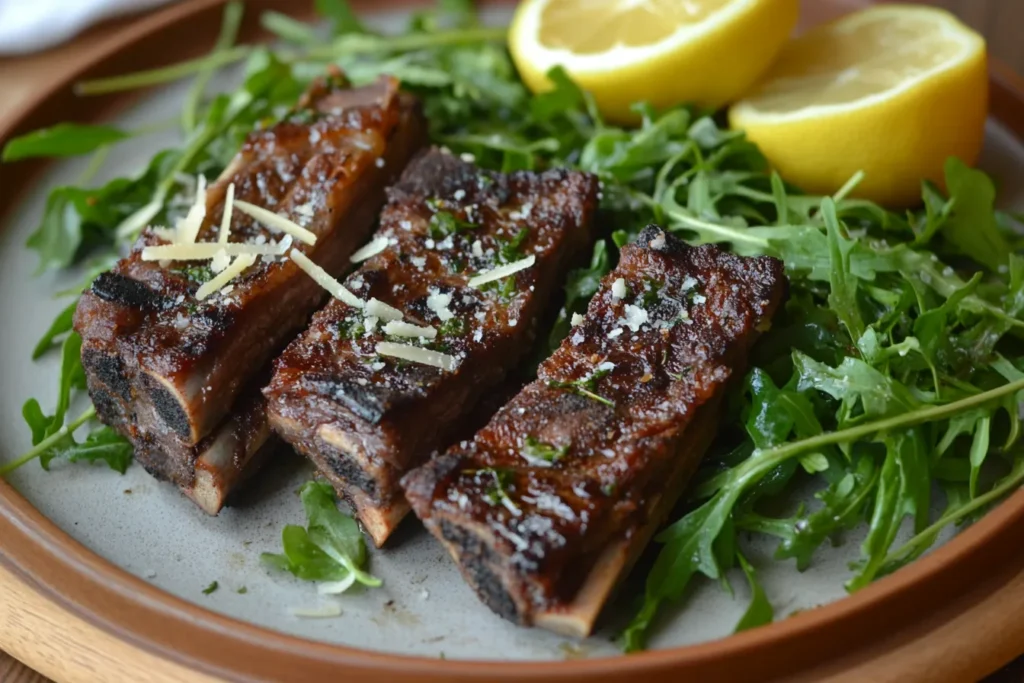
Short Ribs in American BBQ
Slow-smoked short ribs are a barbecue staple, offering a smoky bark and melt-in-your-mouth texture.
Short Ribs in Latin American Cuisine
Mexican recipes often use short ribs in rich, spicy stews like barbacoa or mole.
Fusion Recipes with Short Ribs
Innovative chefs use short ribs in:
- Tacos with Asian-inspired sauces.
- Ramen bowls with a twist.
- Gourmet sliders with caramelized onions and cheese.
FAQs About Cooking Short Ribs
1. How Can You Tell When Short Ribs Are Done?
Perfectly cooked short ribs are fork-tender. You should be able to easily pull the meat apart with a fork, but it should still hold some structure. Visual cues include:
- Meat pulling away from the bones.
- A shiny glaze from rendered fat and gelatin.
2. What Is the Ideal Internal Temperature?
The ideal temperature for short ribs is:
- 190°F-200°F (88°C-93°C): For full collagen breakdown and tenderness.
- Below 190°F: The meat may still be tough as collagen hasn’t fully dissolved. Use a meat thermometer for accuracy.
3. Can Short Ribs Be Cooked in Advance?
Yes, short ribs are excellent for cooking in advance. In fact, they often taste better the next day because the flavors have time to meld. Store them:
- In their cooking liquid to prevent drying out.
- In the refrigerator for up to 3 days.
4. How to Reheat Leftover Short Ribs?
To maintain tenderness:
- Heat in a covered dish with some of the cooking liquid at 300°F (150°C) for 20-30 minutes.
- Avoid microwaving, as it can dry out the meat.
5. Do Bones Matter?
Absolutely. Bones contribute:
- Flavor: During cooking, marrow infuses the meat with richness.
- Moisture: Bones help retain heat, leading to even cooking.
Comparing Short Ribs with Other Beef Cuts
1. Short Ribs vs. Chuck Roast
- Short Ribs: Richer flavor due to higher fat content.
- Chuck Roast: Leaner and better suited for slicing, not as indulgent as short ribs.
2. Short Ribs vs. Ribeye
- Ribeye: A steak cut that’s quick-cooking and tender without long braising.
- Short Ribs: Requires low-and-slow cooking but delivers deeper flavors.
3. Short Ribs vs. Brisket
- Brisket: Larger, leaner, and ideal for smoking.
- Short Ribs: Smaller portions with more marbling, resulting in melt-in-your-mouth tenderness.
4. Similarities with Oxtail
Both short ribs and oxtail are:
- Rich in connective tissue.
- Ideal for braising or slow cooking.
5. Unique Qualities of Short Ribs
Short ribs are prized for their versatility, able to transform from hearty comfort food to gourmet fare depending on the preparation.
Nutritional Value of Short Ribs
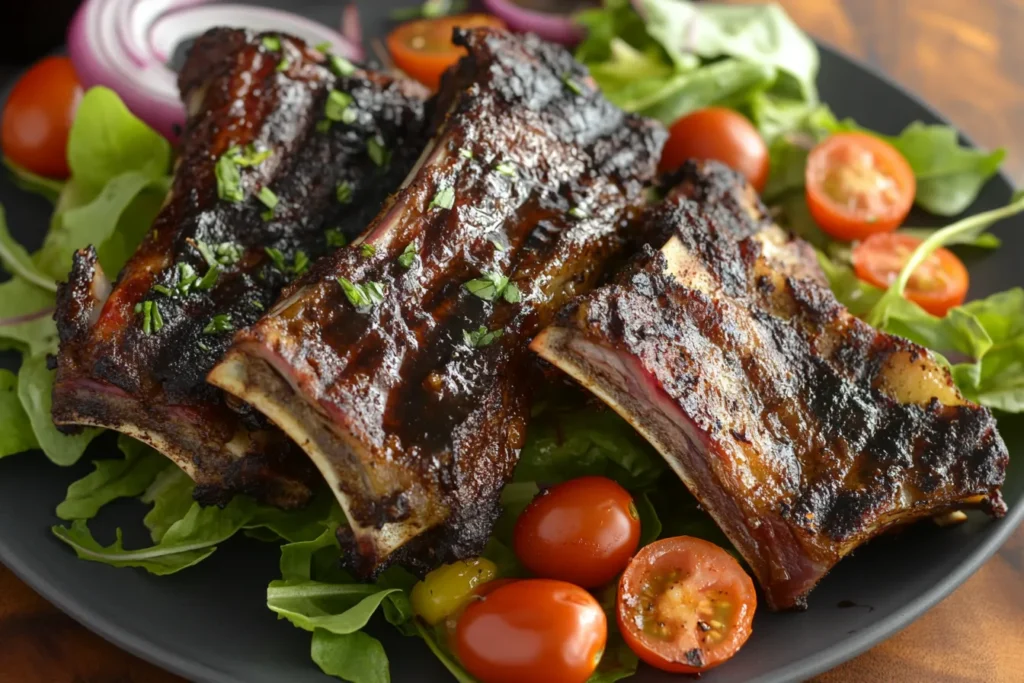
1. Calories and Macronutrients
Short ribs are calorie-dense due to their fat content:
- Per 3-ounce serving: Around 300 calories, with 20g of fat and 20g of protein.
2. Vitamin and Mineral Content
They’re rich in:
- Iron: Boosts energy levels and supports red blood cells.
- Zinc: Essential for immune function.
- B vitamins: Aid in metabolism and energy production.
3. Impact of Fat Content on Diet
While high in saturated fat, short ribs can be part of a balanced diet when paired with healthy sides and prepared using fat-reducing techniques.
4. Health Considerations
To reduce calorie impact:
- Trim excess fat before cooking.
- Skim rendered fat from braising liquids.
5. Balancing Indulgence with Nutrition
Enjoy short ribs occasionally as a treat, focusing on portion control and healthy pairings like roasted vegetables or salads.
Seasonal Considerations for Short Rib Recipes
1. Winter Braises: Perfect for Cold Weather
Hearty dishes like red wine-braised short ribs are ideal for warming up during cold months.
2. Summer Barbecues with Short Ribs
For summer, grilled or smoked short ribs provide a lighter, charred flavor perfect for outdoor gatherings.
3. Seasonal Ingredient Pairings
- Spring: Fresh herbs like mint or parsley.
- Fall: Root vegetables and hearty grains.
4. Holiday Dishes Featuring Short Ribs
Short ribs make for an elegant centerpiece during holidays, especially when served with rich gravies and gourmet sides.
5. Versatility Across Seasons
Whether braised, barbecued, or sous vide, short ribs can be adapted to suit any season with the right accompaniments.
Cultural Significance of Slow Cooking
1. Slow Cooking in Traditional Cultures
Slow cooking has been used for centuries in:
- French cuisine: For dishes like pot-au-feu.
- Asian cuisine: For stews like Korean galbi-jjim.
2. Short Ribs as a Comfort Food
Their rich, hearty texture makes short ribs synonymous with comfort food across many cultures.
3. Evolution of Cooking Techniques
Modern appliances like sous vide machines have elevated the preparation of short ribs, offering precision and convenience.
4. Culinary Traditions Around Braising
Braising remains a time-honored technique for transforming tough cuts into tender, flavorful dishes.
5. Short Ribs in Modern Cuisine
Today, short ribs are a staple in fine dining, showcased in innovative recipes that merge tradition with contemporary flavors.
Budgeting for Short Ribs
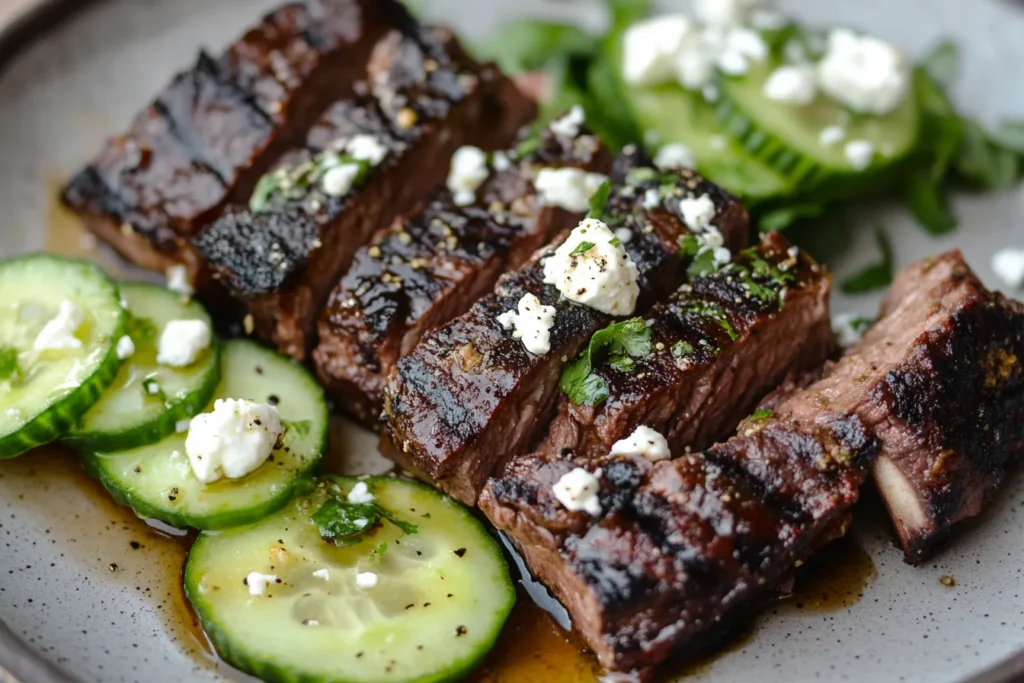
1. Cost Comparison with Other Cuts
Short ribs are more expensive than cuts like chuck roast but more affordable than premium steaks.
2. How to Save Money on Short Ribs
- Buy in bulk.
- Opt for less popular cuts or look for sales at local butcher shops.
3. Choosing Quality Over Price
Grass-fed and locally sourced short ribs may cost more but deliver superior flavor and tenderness.
4. Bulk Cooking for Cost-Effectiveness
Cooking large batches allows you to repurpose leftovers into new dishes like tacos or stews.
5. Alternatives to Short Ribs
For a similar flavor profile, consider beef shanks or oxtails as budget-friendly options.
Environmental Considerations in Short Rib Production
1. Ethical Sourcing of Short Ribs
Choose suppliers that prioritize:
- Humane treatment of cattle.
- Sustainable farming practices.
2. Grass-Fed vs. Grain-Fed Beef
Grass-fed short ribs are:
- Leaner but more flavorful.
- Often more environmentally friendly.
3. Sustainability in Beef Production
Look for certifications like Certified Humane or Animal Welfare Approved to support sustainable practices.
4. Reducing Food Waste in Short Rib Preparation
Repurpose braising liquids into soups or sauces to minimize waste.
5. Supporting Local Farmers
Purchasing directly from local farms helps:
- Reduce the carbon footprint of your meal.
- Support sustainable farming communities.
Conclusion: Crafting the Perfect Short Ribs Experience
1. Recap of Tenderness Factors
Achieving tenderness involves:
- Cooking low and slow.
- Monitoring temperatures and timing.
- Choosing the right cut and preparation method.
2. Importance of Patience in Cooking
The best results come from allowing enough time for collagen to fully break down and flavors to develop.
3. Balancing Flavor and Texture
Perfect short ribs are flavorful, tender, and balanced with complementary sides and sauces.
4. Why Short Ribs Are Worth the Effort
Despite the time and care required, short ribs deliver unmatched richness and versatility, making them a rewarding dish for any occasion.
5. Inspiring Confidence in Cooking Short Ribs
With proper techniques, anyone can master the art of cooking short ribs and create dishes that impress family and friends.
FAQs
Are short ribs suitable for grilling?
Yes, flanken cuts are perfect for high-heat grilling.
Can I freeze cooked short ribs?
Yes, store them in an airtight container for up to 3 months.
What’s the best liquid for braising?
Red wine, beef broth, or a combination of both.
Can I cook short ribs without bones?
Yes, boneless short ribs work well but lack the added flavor of bones.
How long should I marinate short ribs?
At least 4 hours, but overnight is best.
What vegetables pair well in a braise?
Carrots, onions, celery, and potatoes.
Can I cook short ribs in a pressure cooker?
Yes, it significantly reduces cooking time while maintaining tenderness.
Why are my short ribs greasy?
Insufficient trimming or not skimming fat from the braising liquid.
How do I thicken the braising sauce?
Reduce it on the stove or add a cornstarch slurry.
What cut is closest to short ribs?
Beef chuck or oxtail.
